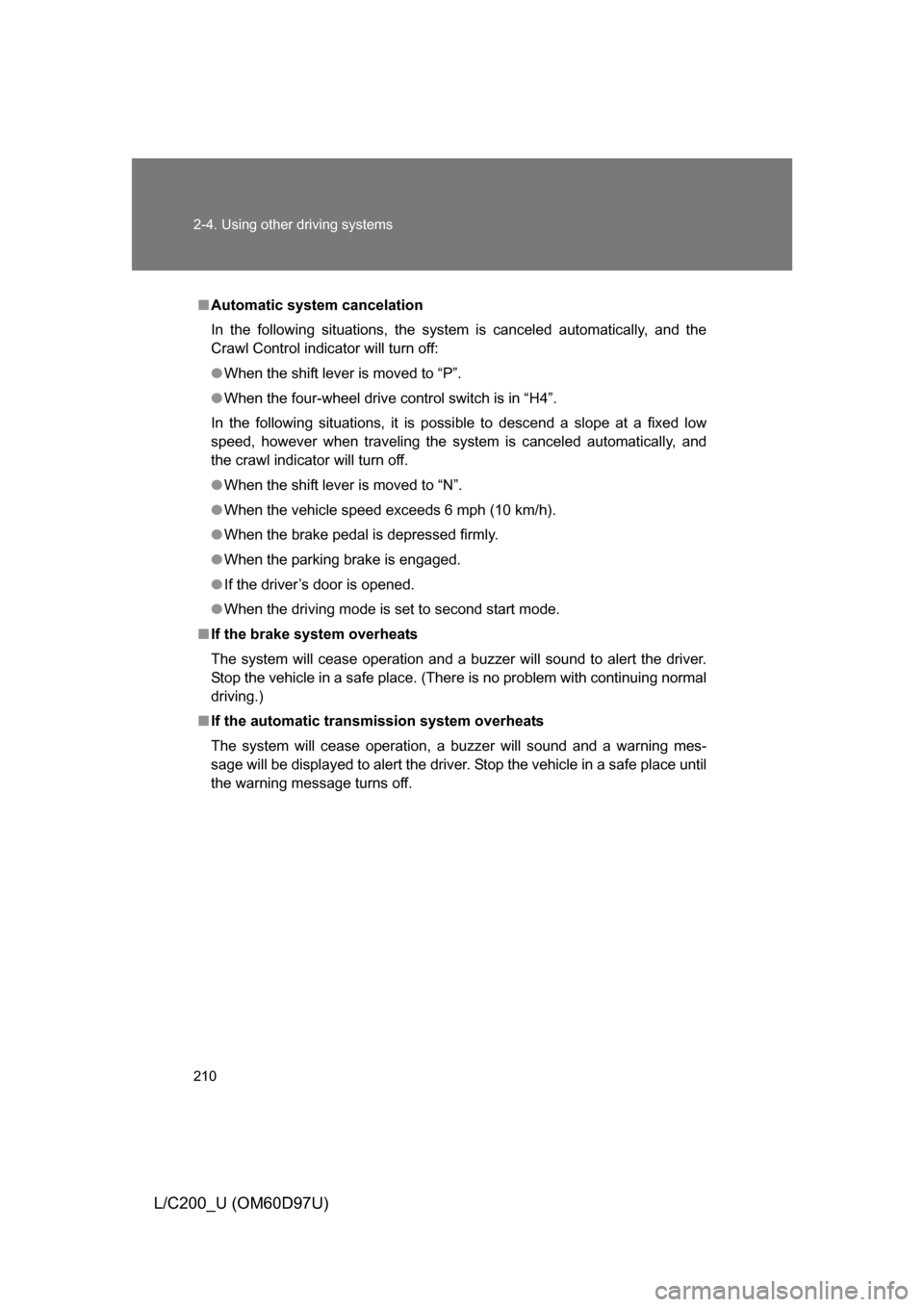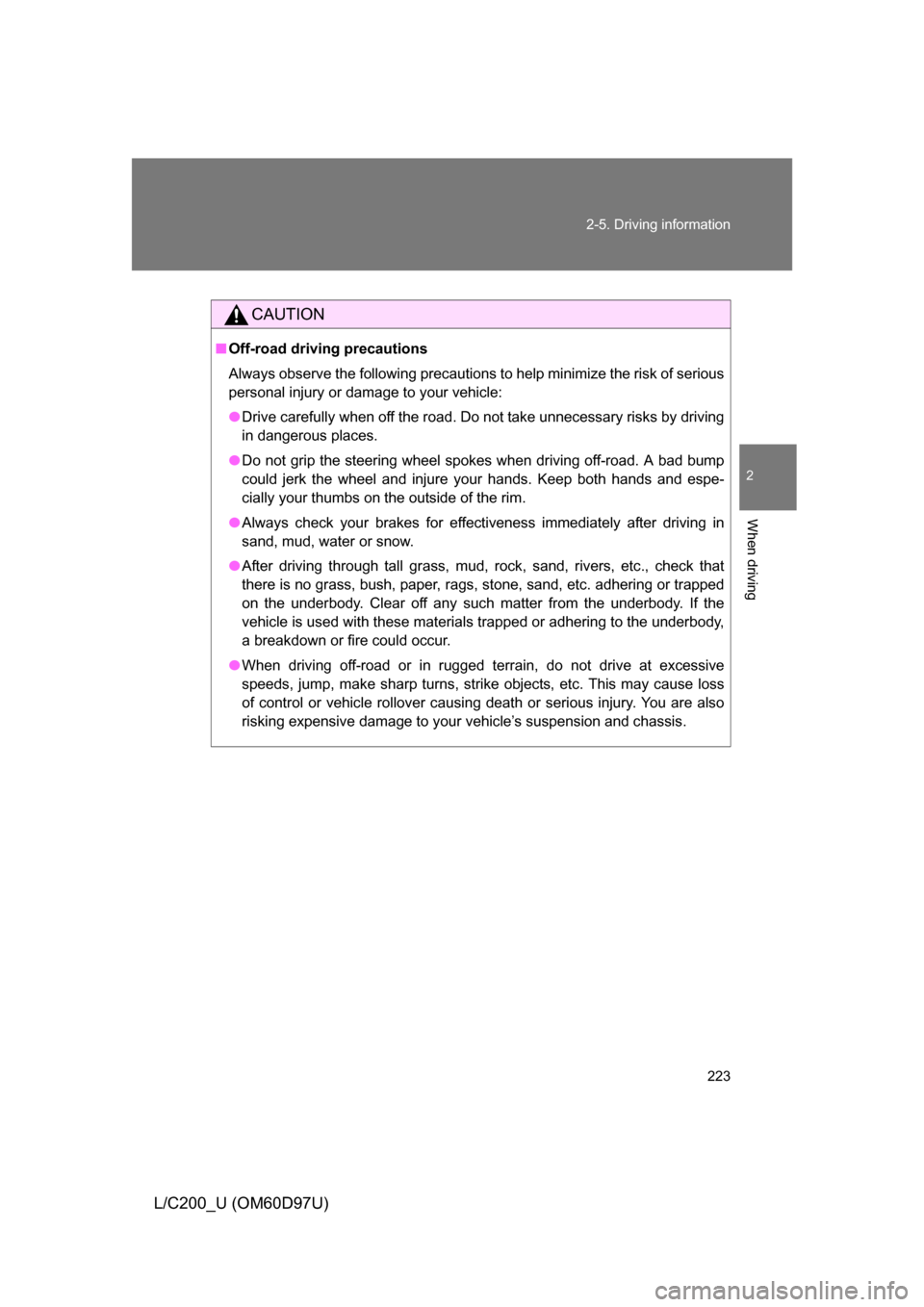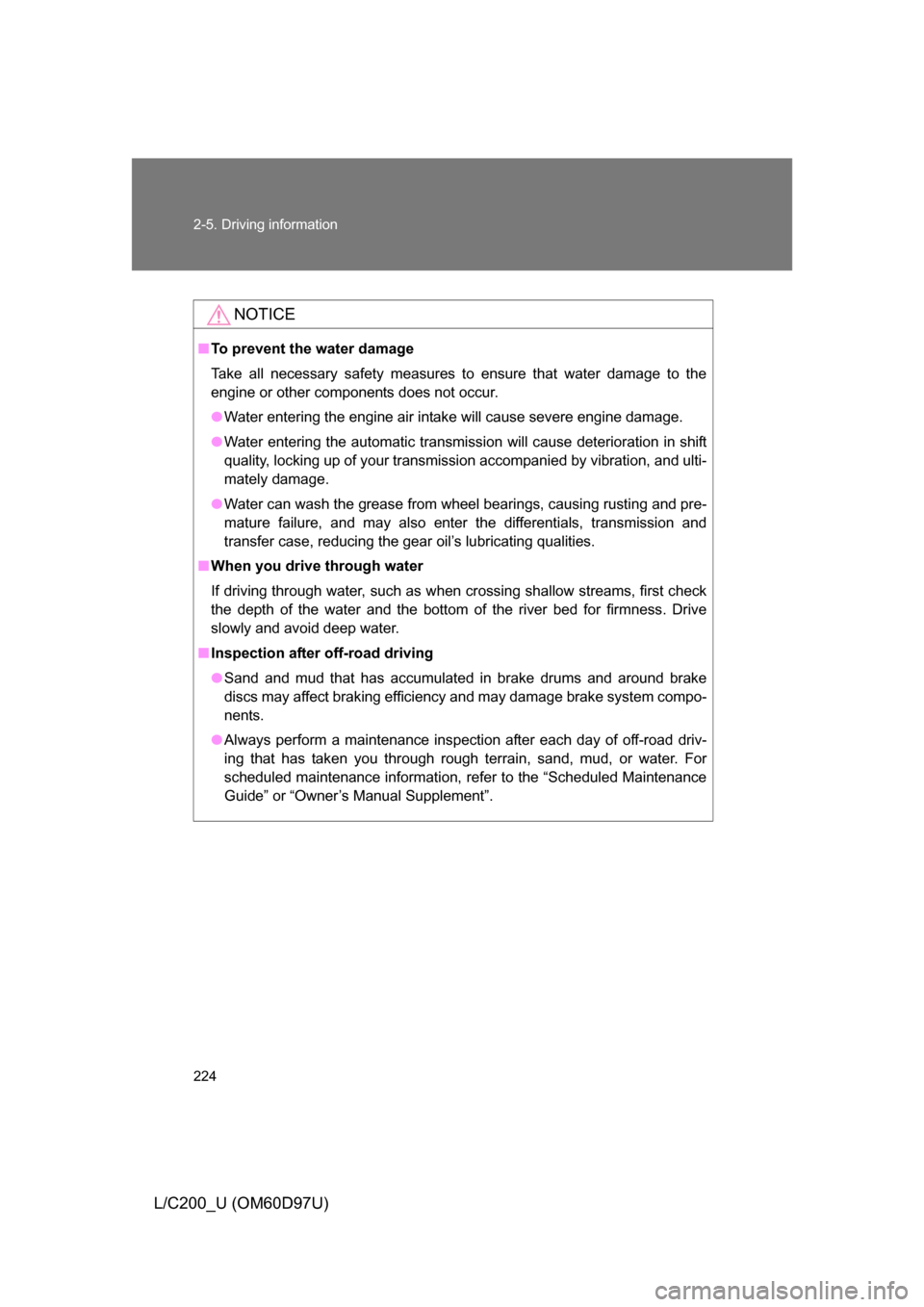Page 208 of 556
208
2-4. Using other driving systems
L/C200_U (OM60D97U)
Crawl Control
Allows travel on extremely rough off-road surfaces at a fixed low
speed without pressing the accelerat or or brake pedal. Minimizes
loss of traction or vehicle slip wh en driving on slippery road sur-
faces, allowing for stable driving.
■ Crawl Control switch
On/off
The Crawl Control indicator is
lit and the slip indicator flashes
when operating.
Speed selection switch
Low mode
Effective when traveling on
rocks and pebbles.
*
Medium mode
Effective when traveling on
snow mounds or descending a
slope of rubble.
*
High mode
Effective when ascending a
slope of rubble, or traveling on
snow, dirt, mud, sand, gravel,
grass etc.
*
*
: Depending on the road sur- face, may not be the most
effective.
ON
SPEED
OFF
ITY24C030
Page 209 of 556
209
2-4. Using other
driving systems
2
When driving
L/C200_U (OM60D97U)
When the system is turned off
If the system is turned off when Crawl Control is operating, a buzzer
will sound for 3 seconds, the slip indicator turns off, and the Crawl
Control indicator flashes until the system has turned off completely.
When turning off Crawl Control while traveling, stop the vehicle
before the Crawl Control indicator turns off, or drive extremely care-
fully.
■ The Crawl Control can be operated when
● The engine is running.
● The shift lever is in any gear other than “P” or “N”.
● The four-wheel drive control switch is in “L4”.
● The parking brake is released.
● The driver’s door is closed.
● When the driving mode is not set to second start mode.
Page 210 of 556

210 2-4. Using other driving systems
L/C200_U (OM60D97U)
■Automatic system cancelation
In the following situations, the system is canceled automatically, and the
Crawl Control indicator will turn off:
● When the shift lever is moved to “P”.
● When the four-wheel drive control switch is in “H4”.
In the following situations, it is possible to descend a slope at a fixed low
speed, however when traveling the system is canceled automatically, and
the crawl indicator will turn off.
● When the shift lever is moved to “N”.
● When the vehicle speed exceeds 6 mph (10 km/h).
● When the brake pedal is depressed firmly.
● When the parking brake is engaged.
● If the driver’s door is opened.
● When the driving mode is set to second start mode.
■ If the brake system overheats
The system will cease operation and a buzzer will sound to alert the driver.
Stop the vehicle in a safe place. (There is no problem with continuing normal
driving.)
■ If the automatic transmission system overheats
The system will cease operation, a buzzer will sound and a warning mes-
sage will be displayed to alert the driver. Stop the vehicle in a safe place until
the warning message turns off.
Page 212 of 556

212
2-4. Using other driving systems
L/C200_U (OM60D97U)
Driving assist systems
To help enhance driving safety and performance, the following sys-
tems operate automatically in res ponse to various driving situations.
Be aware, however, that these systems are supplementary and
should not be relied upon too h eavily when operating the vehicle.
■Multi Terrain ABS (Anti-lock Brake System)
Helps to prevent wheel lock when the brakes are applied suddenly, or if
the brakes are applied while driving on a slippery road surface, or in off-
road conditions (such as rough roads, sand and mud).
■ Brake assist
Generates an increased level of braking force after the brake pedal is
depressed, when the system detects a panic stop situation.
■VSC (Vehicle Stability Control)
Helps the driver to control skidding when swerving suddenly or turning
on slippery road surfaces.
■Active TRAC (Traction Control)
Maintains drive power and prevents the 4 wheels from spinning when
starting the vehicle or accelerating on slippery roads.
■Hill-start assist control
Helps prevent the vehicle from rolling backwards when starting on an
incline or slippery slope. It operates for approximately 5 seconds at
maximum.
■KDSS (Kinetic Dynamic Suspension System)
KDSS enhances ride comfort and handling response by using a
hydraulic control system to control the suspension stabilizer bars in
response to road surface and driving conditions during cornering or off-
road driving.
■PCS (Pre-Collision System) (if equipped)
P. 219
Page 216 of 556
216 2-4. Using other driving systems
L/C200_U (OM60D97U)
■Sounds and vibrations caused by the Multi Terrain ABS, brake assist,
Active TRAC, VSC and hill-start assist control
● A sound may be heard from the engine compartment when the engine is
started or just after the vehicle begins to move. This sound does not indi-
cate that a malfunction has occurred in any of these systems.
● Any of the following conditions may occur when the above systems are
operating. None of these indicates that a malfunction has occurred.
• Vibrations may be felt through the vehicle body and steering.
• A motor sound may be heard after the vehicle comes to a stop.
• The brake pedal may pulsate slightly after the Multi Terrain ABS is acti-
vated.
• The brake pedal may move down slightly after the Multi Terrain ABS is activated.
■ Hill-start assist control is operational when
● The shift lever is in “D” or “S”.
● The brake pedal is not depressed.
Page 219 of 556
219
2-4. Using other driving systems
2
When driving
L/C200_U (OM60D97U)
Pre-Collision System (if equipped)
■The pre-collision system is operational when
● Vehicle speed exceeds 19 mph (30 km/h).
● The system detects sudden braking or skidding.
● The front occupants are wearing a seat belt.
■ When there is a malfunction in the system
Warning message will be displayed on the multi-information display.
(
P. 473)
CAUTION
■Limitations of the pre-collision system
Do not rely on the pre-collision system. Always drive safely, taking care to
observe your surroundings and checki ng for any obstacles or other road
hazards.
The system detects emergency braking from the speed and force
with which the driver presses the brake pedal, and quickly tightens
the seat belt to improve the effectiveness of the seat belt pretension-
ers ( P. 73). This system also oper ates in the same manner when
the vehicle slips sideways.
Page 223 of 556

223
2-5. Driving information
2
When driving
L/C200_U (OM60D97U)
CAUTION
■
Off-road driving precautions
Always observe the following precautions to help minimize the risk of serious
personal injury or damage to your vehicle:
● Drive carefully when off the road. Do not take unnecessary risks by driving
in dangerous places.
● Do not grip the steering wheel spokes when driving off-road. A bad bump
could jerk the wheel and injure your hands. Keep both hands and espe-
cially your thumbs on the outside of the rim.
● Always check your brakes for effectiveness immediately after driving in
sand, mud, water or snow.
● After driving through tall grass, mud, rock, sand, rivers, etc., check that
there is no grass, bush, paper, rags, stone, sand, etc. adhering or trapped
on the underbody. Clear off any such matter from the underbody. If the
vehicle is used with these materials trapped or adhering to the underbody,
a breakdown or fire could occur.
● When driving off-road or in rugged terrain, do not drive at excessive
speeds, jump, make sharp turns, strike objects, etc. This may cause loss
of control or vehicle rollover causing death or serious injury. You are also
risking expensive damage to your vehicle’s suspension and chassis.
Page 224 of 556

224 2-5. Driving information
L/C200_U (OM60D97U)
NOTICE
■To prevent the water damage
Take all necessary safety measures to ensure that water damage to the
engine or other components does not occur.
● Water entering the engine air intake will cause severe engine damage.
● Water entering the automatic transmission will cause deterioration in shift
quality, locking up of your transmission accompanied by vibration, and ulti-
mately damage.
● Water can wash the grease from wheel bearings, causing rusting and pre-
mature failure, and may also enter the differentials, transmission and
transfer case, reducing the gear oil’s lubricating qualities.
■ When you drive through water
If driving through water, such as when crossing shallow streams, first check
the depth of the water and the bottom of the river bed for firmness. Drive
slowly and avoid deep water.
■ Inspection after off-road driving
● Sand and mud that has accumulate d in brake drums and around brake
discs may affect braking efficiency and may damage brake system compo-
nents.
● Always perform a maintenance inspection after each day of off-road driv-
ing that has taken you through rough terrain, sand, mud, or water. For
scheduled maintenance information, refer to the “Scheduled Maintenance
Guide” or “Owner’s Manual Supplement”.